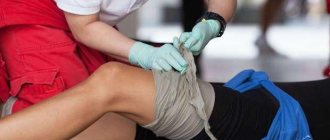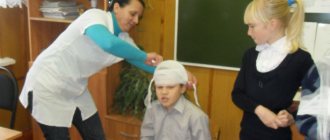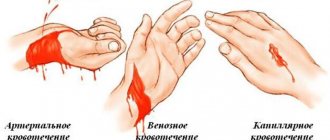Causes of bleeding
The following factors can cause bleeding:
- mechanical damage to blood vessels;
- neoplasm or inflammatory process in the walls of blood vessels;
- deterioration of the integrity of blood vessels due to infection, lack of vitamins or poisoning of the body.
Remember that timely assistance with bleeding can save the victim’s life!
1 Help with bleeding. Types of bleeding
2 Help with bleeding. Types of bleeding
3 Help with bleeding. Types of bleeding
Types and signs of external bleeding
Methods to stop bleeding largely depend on their location. Each type has its own external manifestations, to which you need to react in time:
- capillary bleeding - occurs due to damage to small vessels as a result of injury or illness. It manifests itself first in the form of blood dew, and then as a slow flow of blood beyond the skin. This condition can be especially dangerous for people with bleeding disorders;
- internal (parenchymal) bleeding is a rather dangerous condition observed as a result of damage to internal organs that have a large blood supply network (spleen, liver, kidneys);
- arterial bleeding is the result of damage to the aorta, femoral and other arteries and manifests itself in the form of a stream of bright scarlet color with pulsation. The danger of such blood loss is its rapid nature, and therefore the timeliness of assistance in fractions of a second plays a vital role in avoiding death caused by damage to the main artery;
- venous bleeding is the slowest. The blood flows out thick, dark burgundy in color, and clots may form. Bleeding from a damaged vein is dangerous due to the detachment of a blood clot, significant loss of blood, or the entry of air bubbles into a pulmonary vessel.
Types of bleeding
The type of bleeding depends on which vessel is damaged, in which part of the body it is localized, and the intensity of blood loss.
Classification according to the type of damage to blood vessels:
- capillary bleeding;
- venous;
- internal (parenchymal);
- arterial;
- mixed bleeding.
Classification according to the cause of bleeding:
- abnormal bleeding;
- traumatic.
Classification according to the location of blood loss:
- external;
- internal.
Classification by volume of blood loss:
On average, about 5 liters of blood circulates in the body of an adult. Depending on the volume of fluid spilled, doctors distinguish the following degrees of blood loss:
- mild degree (less than 0.5 liters);
- medium (less than 1 liter);
- heavy (about 1.5 liters);
- massive (about 2.5 liters);
- lethal (about 3 liters), i.e. more than half of the total blood volume;
- absolutely lethal (more than 3.5 liters), i.e. above 60%.
First aid for bleeding is a system of therapeutic and preventive measures that must be taken in case of damage to blood vessels (arteries, capillaries and veins) until qualified medical assistance becomes available. Each type of bleeding has its own characteristics in providing assistance.
Types of venous bleeding and general manifestations
The division of venous bleeding into several types is associated with the characteristics of their occurrence, different dangers and treatment tactics. It is important to remember that the following may be damaged:
- Superficial veins of the upper and lower extremities;
- Deep veins;
- Veins of the neck and head.
Each of these bleedings carries a different danger to life. The most important criteria that suggest a vein is damaged may be the following symptoms:
- The presence of wounds of any type (stab, cut, gunshot, shrapnel, etc.) in the places where veins are located and run;
- Blood flows out in a constant rapid stream without interruption;
- The blood is dark red in color;
- Preferential outflow of blood from the peripheral end of the damaged vessel;
- Percutaneous compression of the vein near the wound reduces the rate of blood loss.
The causes of injury are most often associated with stab wounds, gunshot wounds and suicide attempts.
General rules of first aid for bleeding
If the victim has lost a significant amount of blood, try to lay him down and elevate his legs.
Do not touch the wound with your hands or remove glass shards from it.
If sand and rust get into the wound, do not wash the damage, as this will increase the bleeding.
If the wound becomes dirty, you need to carefully remove the dirt in the direction from the wound, then treat the cleaned edges with an antiseptic.
When treating the edges of a wound with an iodine solution, do not allow the antiseptic to get inside the wound.
Depending on the type of blood loss, try to stop the bleeding using a tourniquet, twisting, or squeezing the damaged vessel.
First aid for capillary bleeding
Bleeding from the capillaries is not accompanied by large blood loss and stops relatively quickly. A sign of capillary damage is the appearance of a gentle stream of blood on the wound.
First aid for this bleeding includes treating the edges of the wound with an alcohol antiseptic (iodine), on which an aseptic gauze bandage is applied. Please note that the bandage is not tight. Usually, with capillary bleeding, there is no need to go to the hospital, with the exception of situations where the damage is extensive.
1 First aid for bleeding
2 First aid for bleeding
3 First aid for bleeding
First aid for venous bleeding
A sign of venous bleeding is rapidly flowing dark blood. Its flow is uniform, without gushing or pulsating.
With venous bleeding, blood clots may appear; they cannot be removed, since in this case blood loss may increase.
To stop bleeding, apply a pressure aseptic bandage to the wound. If blood loss continues, it is necessary to apply a tourniquet below the damaged area. To reduce injury to soft tissues and skin, a soft pad is placed on them (under the tourniquet). It is necessary to make a note indicating the time of application of the tourniquet. The maximum time for wearing a tourniquet is 2 hours in warm weather and 1 hour at sub-zero temperatures. The tourniquet cannot be held longer than this time, otherwise the bloodless tissue will begin to die. If you don’t have a tourniquet, you can make twists from available materials: a bandage, a belt, a towel, a piece of fabric using a handle and a short stick. The time frame for the spins is the same. Try not to use any hemostatic drugs without a doctor's prescription.
First aid for arterial bleeding
Arterial bleeding is one of the most dangerous. The main sign of arterial damage is bright scarlet blood flowing out in a pulsating stream at high speed. If large arteries are damaged, the blood begins to flow intermittently, like a fountain.
First aid for this bleeding is to apply a hemostatic tourniquet above the level of the wound. You can also use a twist. Time restrictions are the same.
If there is no tourniquet or twist, you can stop the bleeding by pressing the artery above the damaged area with your finger, i.e. at the pulsation point.
In case of bleeding from the brachial, ulnar, femoral or popliteal artery, you can fix the arm or leg as bent as possible in an elevated position.
Bleeding from superficial veins
Even complete transection of any of the saphenous veins of the extremities cannot cause circulatory problems. But, despite this secondary importance of this group of vessels, venous bleeding from them that is not stopped can result in massive blood loss incompatible with life. It is very important to know the places that are especially dangerous in this regard:
- Venous network of the inner surface of the wrist;
- Central veins along the inner and outer surfaces of the forearm and shoulder;
- The great saphenous vein of the leg and thigh with main tributaries, which are located on the inner surface of these segments of the lower limb;
- Venous plexuses of the dorsum of the foot.
Clinical features and signs of venous bleeding caused by damage to the listed vessels are as follows:
- The lower end of the damaged vein bleeds to a greater extent, which is associated with the centripetal direction of venous blood flow (from bottom to top);
- Damaged small saphenous veins are capable of thrombosis on their own, which will lead to spontaneous cessation of bleeding;
- The intersection of the main saphenous veins of the thigh and shoulder rarely ends with spontaneous stopping of blood loss;
- Increased bleeding is caused by high blood pressure, alcohol intoxication, and diseases of the blood system (hemophilia, leukemia, thrombocytopenia).
All these circumstances predetermine the tactics of first aid and the final stop of venous bleeding from the subcutaneous vessels of the extremities. The methods could be:
- Pressing down a bleeding vessel below the wound site through the skin. If this does not lead to a complete stop of blood loss, the end of the vein above the wound is also compressed;
- Rinse the wound with hydrogen peroxide or any water-based antiseptic and then cover it with a bandage and gauze pressure bandage. It should cover the wound area with the skin above and below the wound. Before bandaging, you can place a gauze roll soaked in peroxide into the wound itself;
- Bleeding from superficial veins can be completely stopped either by simply suturing the skin wound, or by combining it with ligation of both ends of the bleeding vessel.
Applying a pressure bandage is one of the methods for temporarily stopping venous bleeding
Important points
Providing first aid for bleeding involves a number of important points that need to be taken into account.
- You should not feel the pulse in the place where the tourniquet is applied.
- In case of swelling and blueness of the limb, the tourniquet is removed and then reapplied.
- For wounds on the leg, the artery is pinched as close to the groin area as possible.
- If the lower leg is injured, the tourniquet is placed under the knee with the obligatory use of any hard object.
- Bleeding in the thigh area is also stopped with the help of a tourniquet, which is applied to an object closer to the groin.
- After the bleeding has stopped, first aid consists of covering the wound with a bandage. Ideally, it should be sterile. However, if this condition cannot be met, then any clean cloth will do.
- If the carotid artery is damaged, the tourniquet is used only through tissue, preferably soft. It is important that it lightly compresses the wound.
- Do not perform any actions in the wound with your hands.
- Do not clean open damage yourself!
- If there is an object in the wound, you cannot remove it!
- Even if the bandage is covered in blood, only doctors can change it.
When performing first aid for wounds and bleeding, compliance with these rules is mandatory.
Rules for applying a bandage
Before proceeding to stop bleeding, it is necessary to analyze the severity and nature of the damage.
- First aid for arterial bleeding: technique of applying a tourniquet and sterile dressing
Having determined that it is the vein that is injured, it is worth assessing the location of the cut : was it external or deep that was damaged?
Then an excellent solution would be to apply a pressure bandage, which can stop minor bleeding.
It is applied in any case and at any depth of the cut, but if the injury is deep, it is preceded by the application of a tourniquet.
Rules for applying a pressure bandage:
- You should use only aseptic materials, that is, sterile, to avoid infection entering the wound surface and further development of systemic infection;
- Before manipulation, it is necessary to generously treat the edges and the area around it with an antiseptic solution (hydrogen peroxide is preferred, chlorhexidine, betadine, iodine, brilliant green);
- After treatment, apply a sterile napkin soaked in the same antiseptic solution to the wound (it is better not to use brilliant green or iodine in this case);
- Twist a tight roll of cotton wool, which is placed along the wound to prevent fluid from leaking out;
- The roller is fixed to the wound site with a long sterile bandage, and each subsequent roll of bandage should be stronger than the previous one. Such gradual compression will provide maximum comfort to the patient and prevent the development of numbness (if the limb is injured).










